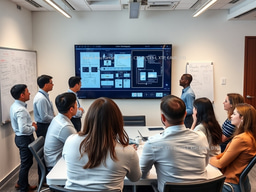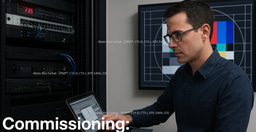LED Video Wall Installation in Open Space.

Installing an LED video wall in an open space is a complex task that requires careful planning and adherence to industry standards. As LED technology continues to advance, video walls have become a popular choice for displaying dynamic content in various environments, including corporate spaces, retail stores, concert venues and sports arenas. To ensure optimal performance, longevity and a seamless viewer experience, it is essential to follow best practices established by the audiovisual industry.
When choosing LED technology for a video wall, the pixel pitch is a crucial consideration. Pixel pitch affects image resolution, viewing distance and cost. Smaller pixel pitch provides higher resolution and is suitable for close viewing and detailed content. Larger pixel pitch is cost-effective for outdoor installations and situations with greater viewing distance. The content type, available space and desired viewing angle should also be taken into account. Striking a balance between visual requirements and budget constraints is essential.
I will list some points for installing an LED video wall in an open space, elaborating on the technical considerations and professional approaches that should be taken into account based on my perspective, filed/design experience. By following these guidelines, AV professionals/installer can ensure that the installation meets the highest standards of quality, efficiency, and safety.
- Assess the Environment:
Before installing an LED video wall in an open space, a thorough assessment of the environment is essential. Consider factors such as ambient lighting conditions, viewing distances and potential obstacles that may affect visibility. Conduct a site survey to gather data and measurements, which will help in determining the appropriate specifications for the video wall.
- Plan the Layout:
Based on the assessment, plan the layout of the LED video wall. Consider the desired size, aspect ratio, resolution, and pixel pitch. These factors depend on the viewing requirements, available space, and the type of content to be displayed. It is crucial to strike a balance between the size of the video wall and the viewing distance to ensure optimal viewing experience.
- Structural Considerations:
The structural integrity of the wall or structure where the LED panels will be mounted is of utmost importance. LED video walls can be heavy, so it is essential to ensure that the wall can bear the weight.( min safety factor should be > 5) and advice to Consult with a structural engineer to assess the load-bearing capacity and make any necessary reinforcements to the installation site.
- Power and Electrical:
An LED video wall requires a sufficient and stable power supply. Verify that the electrical infrastructure can handle the power requirements of the video wall, taking into account the power consumption of the LED panels , video processing equipment and any additional components. (Taking into consideration maximum power consumption requirement ). It is important to ensure that power outlets are easily accessible and properly grounded to avoid electrical issues.
- Cooling and Ventilation:
LED video walls generate heat during operation, so proper cooling and ventilation are crucial to prevent overheating and ensure optimal performance and longevity. Consider the heat dissipation characteristics of the LED panels and consult the manufacturer's specifications for recommended cooling systems. Install fans, heat sinks, or other cooling solutions as necessary, ensuring that they do not interfere with the viewing area or create excessive noise.
- Cable Management:
Efficient cable management is essential for a clean and organized installation. Plan the routing and management of cables to avoid tangling and damage. Consider using cable trays, conduits, or raceways to conceal and protect the cables. Proper labeling of cables will facilitate maintenance and troubleshooting in the future.
- Calibration and Testing:
After the installation is complete, calibrate the LED panels to ensure uniform brightness, color accuracy, and image quality across the entire video wall. Calibration involves adjusting parameters such as gamma correction, color temperature, and color balance. Perform thorough testing of the video wall to identify and address any issues related to dead pixels, non-uniformity or image artifacts.
- Maintenance and Serviceability:
Consider the ease of maintenance and serviceability when designing the installation. LED panels may require periodic cleaning to remove dust and debris that can affect image quality. Ensure that access to the panels is convenient and safe, allowing for easy removal and replacement if necessary. Components such as power supplies, control systems and video processors should also be easily accessible for maintenance or upgrades.
- Safety Measures:
Safety should be a top priority during the installation process. Adhere to applicable safety standards, regulations, and local building codes. Ensure that the video wall is securely mounted to prevent accidental dislodging or falling. Properly insulate all electrical connections to prevent electrical hazards or short circuits.
- Documentation:
Maintain comprehensive documentation throughout the installation process. This documentation should include site surveys, diagrams, specifications and any modifications made during the installation ( Specially LED modules location Diagram) . Proper documentation will be valuable for future reference, troubleshooting (LED modules replacement) and when planning upgrades or expansions to the video wall system.
While these guidelines provide a general framework for installing an LED video wall in an open space, it is important to note that specific requirements may vary based on the manufacturer, model and unique characteristics of the installation site. Always refer to the manufacturer's instructions, consult qualified professionals, and stay updated with the latest developments and industry standards through resources such as AVIXA's website or AVIXA Xchange. By following these professional guidelines and staying informed, AV professionals can ensure a successful LED video wall installation that delivers exceptional performance and viewer experience.
-
Xchange Advocates are recognized AV/IT industry thought leaders and influencers. We invite you to connect with them and follow their activity across the community as they offer valuable insights and expertise while advocating for and building awareness of the AV industry.
Recommended Content
LetsTalkAVbyAlexis Series: Episode 4 : Design Begins With People: Engineering AV Systems Around Real End-User Requirements

LetsTalkAVbyAlexis Series : Episode 2: Network & AV Convergence (AVoIP)





Please sign in or register for FREE
If you are a registered user on AVIXA Xchange, please sign in